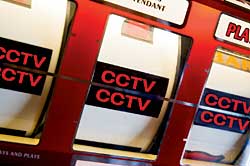
Hitting the Jackpot
The digital revolution plays a sweeping role in casino video surveillance
- By Del V. Salvi
- Mar 02, 2007
 IN
IN the past five years, the world of video surveillance has experienced what is best known as the digital revolution. The migration from old, analog recording systems to DVRs has been sweeping. Walking the aisles at ISC West, one is bound to hear what has become an all too familiar murmur: “My, I can’t believe how pervasive and dominant DVR technology has become at this show.” Some have even joked, suggesting to rename the show the International Video Surveillance conference. The reality is everyone seems to have jumped onto the digital bandwagon. Casinos, the quintessential king of the hill when it comes to video surveillance technology, employ digital surveillance when it comes to security.
The early performance barriers of real-time recording speeds, digital matrix capabilities, high-storage costs and the legal court system’s acceptance of watermarking digital video all seemed to take longer than digital technology evangelists would promise year in and year out.
In the early days of DVRs, systems could range up to $6,000 per camera, much higher than the cost of analog technology. In addition to the financial burden, there also was a legitimate concern over certain performance constraints—such as the need to have real-time recording speeds on every camera used to watch table action on the casino floor. At $6,000 per camera, the change to digital was not going to happen. Early adoption of using digitally recorded images were used in court. Protocol and precedent simply did not allow for the technology with any degree of certainty. Digital technology, while interesting, was just an impractical novelty, one that seemed a distinct possibility. And so surveillance investments continued to flow full stream ahead, but only in the direction of the older, less expensive, more reliable VHS analog systems.
Digital MigrationThe early performance barriers of real-time recording speeds, digital matrix capabilities, high-storage costs and the legal court system’s acceptance of watermarking digital video all seemed to take longer than digital technology evangelists would promise year in and year out. Even so, once technology barriers were broken, there was still the small obstacle of budget constraints. Digital technology was—and always will be—more expensive than its analog predecessor. And, with millions of dollars invested in analog technology, a technology that met the needs of most casino surveillance departments, it is not surprising that the transition to digital technology was slow to be embraced.
However, as with most technological advancements, benefits of the technology eventually prevail. Those benefits are now beginning to mount. In the next three to five years, most experts believe the last stronghold of analog surveillance technology will finally fall. After all, casinos are already seeing the benefits digital video surveillance systems bring its bottom line.
Digital systems store compressed video files on a system’s hard drive. The compression technology currently in use allows a file to be retrieved multiple times for years, if need be, with virtually no degradation of the image. Images appear as crisp and clear as the day recorded, regardless of how many times the video has been copied, stored or replayed. And today, the cost of storage is far less expensive, even pennies on the dollar, compared to the cost of a VHS tape replacement. The cost of VHS tapes will continue to rise as the demand for that technology continues to decline. Consequently, the temptation for surveillance departments to overuse existing VHS tapes becomes even greater. This problem only adds to overall costs of using analog technology. Gaming commission officials are known to hand out steep fines when they catch surveillance departments overusing VHS tapes.
Moreover, digital systems allow for quicker response times from surveillance department personnel. Operators are able to immediately retrieve video from any camera, literally within seconds of a request. Not only is this a major improvement from a customer service standpoint—not having to force patrons to wait several minutes each time a review is necessary—it also can mean the difference between apprehending a suspect before they are able to make an escape from the premises. With quicker response time also come labor and staffing efficiencies. Consider the dollar value attached to protecting gaming patrons. Protecting the gaming patron is not only paramount to building a loyal client base in today’s competitive environment—it is an absolute necessity for casino survival.
Today’s digital systems are capable of integrating with other security and management systems used throughout the casino property. The end result when video is integrated with the individual systems is an exponential increase in the effectiveness of each system. This is simply not possible with analog systems.
Take, for example, a new technology now growing in popularity among casino properties—RFID-enabled gaming chips. To use the technology, a casino installs sensors beneath each of the betting stations at tables. When a player places a bet, if it is not positioned properly, the dealer will move the bet to the right spot, the spot where the cameras above the tables can see the bet and where the sensors below the table can read the RFID tags built into the betting chips.
If the player has bet seven chips, and the cameras see all seven, but the RFID system counts only six chips, one chip is not equipped with an RFID tag—at least not one the system can read. If all the chips used in the casino contained readable RFID tags, the pit boss will likely get a message from security that the player who has just bet seven chips has a counterfeit chip in their possession. Alerts will go out. CCTV cameras recorded on digital systems will automatically photograph the player, register the location, note the event and track the player through the casino. Immediate questions will be asked. Who is the player? Are they known as a counterfeiter? Catching, identifying and apprehending cheaters like this is far more likely with an integrated digital system at large. Again, consider the enormous costs at stake. Not only are there the costs of a cheater playing for free, but what if the player wins big?
Another example of how digital surveillance system can enhance existing security and management tools used throughout casino properties is the ability to interface with various POS systems. These systems are used in the property’s restaurants, bars and gift shops. Retail theft, both by customers and employees, is every bit as egregious in a casino property as it is in any other retail environment. Having the ability to link every transaction to real-time video is no small deterrent, especially when users can sort, query and retrieve the transaction and video data by virtually any combination of criteria.
Everyday DigitalCase studies indicate analog video surveillance systems simply cannot produce the same results, as digital. Being able to match items sold with real-time video of each sale brings enormous accountability to patrons and employees who are tempted to be less than honest in the processing of transactions. Remember, many times the employee is collaborating with the customer on the theft. Digital video systems with POS integration can spot the type of theft and stop it dead in its tracks. Triggers can be programmed for certain kind of transactions to be reviewed immediately—even viewed live while still in progress.
Cash drawer shortages also can now be easily traced. Each transaction’s video is recorded, along with pertinent POS information. Surveillance departments, suspicious of employee theft, are no longer forced to search for the proverbial needle in the haystack. Security officials simply key in the item, register number, dollar amount or cashier in question, along with a specific date or time period they want to review, and instantly retrieve all the pertinent information.
Access control systems also can be integrated with modern digital systems. Similar to POS integration, access control database information can be searched and queried for visual confirmation of employee use of a particular area. With central monitoring capabilities, an employee’s identification can be confirmed or denied visually in real time, and access can be granted or denied instantly by a surveillance or security department representatives. Security representatives no longer need to be stationed throughout the property at every critical checkpoint. The video surveillance representative can allow or deny access to virtually anywhere within the system’s control. The process can be done at any time, all with the click of a mouse.
DVR systems are not alone in technology cost-savings advances. There also are significant technology improvements that have been achieved in cameras not yet employed by most casino security departments. Most casino properties, by today’s standards, are still using low-resolution cameras. Not only is there a great deal of opportunity to increase clarity through much higher resolution cameras, but there also is significant improvements where difficult lighting conditions exist. Oftentimes, when a review is requested from the pit boss, the result comes back inconclusive, due to a lack of clarity in the recorded video. What good is it to have the recorded video, but not be able to make out with certainty what has been recorded? This can cost an enormous amount of money in payouts to mistakes claimed by gamers that were not in fact mistakes at all. When the casino can’t confirm the information, the policy is to pay. All it takes is one big payout that shouldn’t have been reversed, all because of an inconclusive challenge.
The Digital BenefitCasinos also are famous for deploying PTZ cameras. Both zoom power and quality capabilities have increased substantially in the last three years. Not only is that meaningful, but tour and preset capabilities also have improved exponentially on new PTZ cameras. All of this is enhanced even more by the superior D1 quality recording resolution now possible with digital systems.
Perhaps one of the most intriguing new technologies facilitated by digital systems is the ability for true 360-degree camera views to be recorded and viewed live at the same time. Digital technology now allows for a non-distorted, 360-degree view from a single camera. Surveillance personnel can even zoom in and out on live video with technology, even when the camera is not PTZ. Analog technology simply cannot approach the level of performance.
So, with all the substantial advantages of digital technology, are there still significant cost barriers lurching in its way?
The fact is, while the price of a digital system may still be slightly higher than its analog ancestor, the actual cost of a digital system is substantially lower. More and more gaming industry CFOs are beginning to realize a transition to digital technology can equate to a substantial increase in next year’s bottom line. In the coming years, many believe one significant difference between those CFOs who opt to make the transition compared to those who do not, may very well be the size of their performance bonus at the end of the year. When real dollars are dropped to the bottom line, budgetary constraints fly out the window.